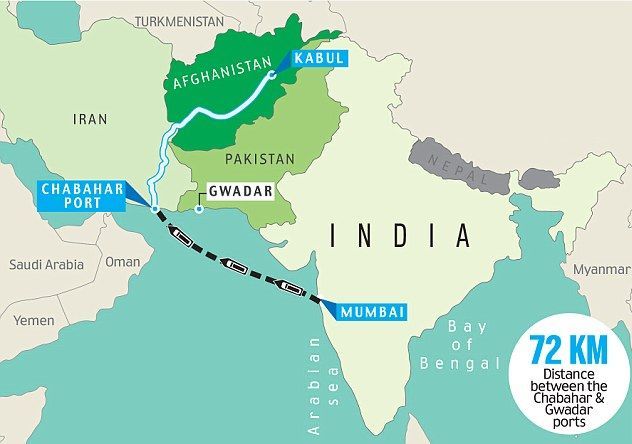It has been extensively covered in media outlets that Iran has dropped India out of the Chabahar Rail project. This post aims to provide proper context to this news.
[Though Iran has clarified now that it did not drop India out of the rail project and vested interests were behind these reports, it is a good time to understand the strategic implications of this project for us.]
In the year 2016, Prime Minister Modi had paid a bilateral visit to Iran. Several agreements related to Chabahar port were signed during this visit:
- Development and operation of two terminals and 5 berths with cargo handling capacities in Chabahar port for 10 years. [India and Iran want to develop a port that can handle a cargo of 80 million tonnes]
- The construction of the Chabahar-Zahedan railway line. [This was a trilateral agreement between India, Iran, and Afghanistan.]
Over the years, the Chabahar project has grown and it now includes a port, free trade zone, railway line from Chabahar to Zahedan, and further from Zahedan to Sarakhs on the border with Turkmenistan.
The first phase of the port development project was inaugurated in December 2017. The port became operational in 2018 and it allowed India to export wheat to Afghanistan.
Iran formally handed over the port to India for the implementation of the Chabahar Agreement in 2018.
Though the operations at the port started in the year 2018, the railway project had to face a lot of delays. It was reported that Iran has decided to go ahead with the rail project on its own. Iran clarified that it is not the case.
Hence, India is not out of the Chabahar port project. It is not out of the rail project. Free trade zone or FTA is anyway open to investors from all over the world.
Nevertheless, what happened to the rail project? Why is it facing delays? The delays are due to the changing international regulations with respect to Iran. Sanctions were imposed on Iran in the year 2006 as it refused to halt its uranium enrichment program. (Uranium is an element used in nuclear fuel). In the year 2015, a deal was negotiated between P5+1 (5 permanent members of the UN and Germany) and Iran known as the Joint Comprehensive Plan of Actions or JCPA. This deal imposed limits on Iran’s nuclear power programs for at least 10 years, in exchange for the removal of sanctions.
India entered into the Chabahar port agreement around the same time in 2016, but the US withdrew from the nuclear deal (JCPA) in 2018 and reimposed sanctions. India and Iran continued to trade for some time through Indian-rupee based payment system as a way around these sanctions. Iran was the largest importer of Indian tea in 2019. But, India had to give in to US pressures to discontinue its oil imports from Iran.
Though there was a sanction-waiver on the development of the port, the status of the rail project remained unclear. India found it difficult to find equipment suppliers and partners for building the railway tracks due to uncertainties.
Chabahar port has significant economic and strategic implications for India. It is a gateway to Afghanistan and Central Asia by bypassing Pakistan [Pakistan has blocked access to Afghanistan through its territory). India needs this route to trade and access iron and other natural resources from Afghanistan and central Asian countries like Turkmenistan, Kazakhstan, and Uzbekistan. The Chabahar port will cut transport costs/time for Indian goods by a third.
Moreover, Chabahar port is close to the Gwadar port in Pakistan, which is developed by China as part of the Belt and Road in initiative/ BRI. This project provides India with a counter to the rising Chinese influence in the region. Western countries can also reduce their dependence on Pakistan and China by using this port to access Afghanistan.
[You may also read: Everything You Need To Know About China’s Belt and Road/ BRI initiative]

Therefore, the reports of India being dumped out of the Chabahar rail project in the backdrop of China completing a major deal with Iran alarmed India.
China and Iran are close to sealing an ambitious deal on an economic and security partnership…
The seeds were sown during Chinese President Xi Jinping’s visit to Iran in January 2016…
it will facilitate the infusion of about $280 billion from Beijing…China will also invest $120 billion into Iran’s transport and manufacturing infrastructure, thus giving it inroads into major sectors in Iran including banking, telecommunications, ports and railways. Iran is already a signatory of China’s Belt and Road Initiative (BRI), and this is in line with China’s “debt-trap diplomacy”
what is alarming for New Delhi is that Beijing is also concluding a security and military partnership with Tehran. It calls for “joint training and exercises, joint research and weapons development and intelligence sharing”
Source: Indian express
Chinese contracts are designed to lure poor countries into a debt trap (known as China’s “debt-trap diplomacy”). Sri Lanka learned it the hard way when it had to lease its Hambantota port to China for 99 years for its inability to repay loans taken to build the project. This can spell disaster if China acquires strategic assets in Iran.
To conclude, even if India is still a major participant in the Chabahar port project, we have to be wary of Chinese making inroads into the region.
Other posts that you may read:
- What is the trade war between US and China?- Explained
- Companies to move manufacturing out of China– Will India benefit?
- Why a complete boycott of Chinese goods is impractical?
Economyria is now on Telegram. For a simplified analysis of topics related to economy/ business/ finance, subscribe to Economyria on Telegram
Thank us by sharing this article with your friends 🙂
Appreciating your Efforts!!!!
Thank you 🙂 Do share about the blog with your friends and family 🙂
Very well written.
Good understanding of geo politics
Thank you, Dhanvin 🙂